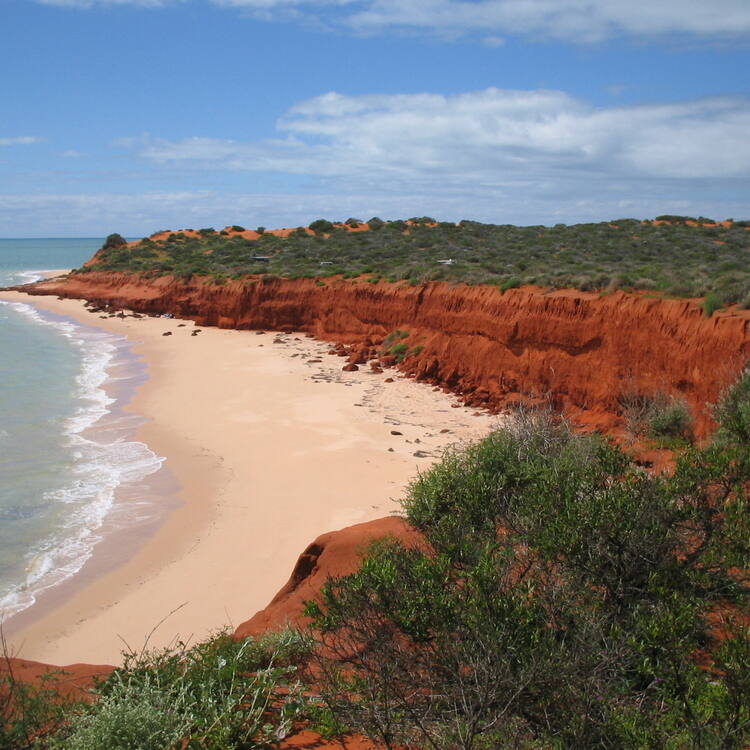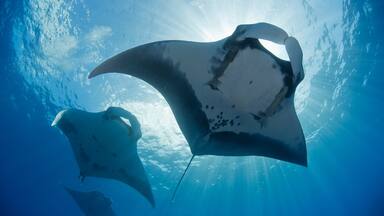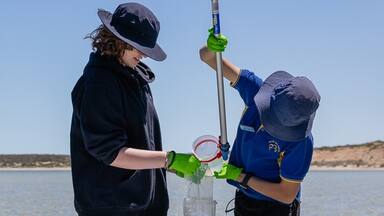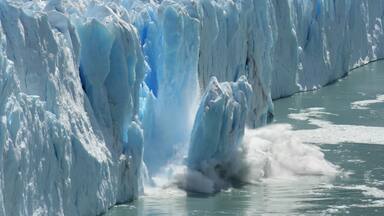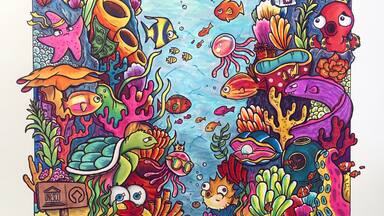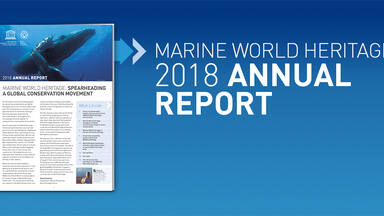Shark Bay, Western Australia
Shark Bay, Western Australia
At the most westerly point of the Australian continent, Shark Bay, with its islands and the land surrounding it, has three exceptional natural features: its vast sea-grass beds, which are the largest (4,800 km2) and richest in the world; its dugong (‘sea cow’) population; and its stromatolites (colonies of algae which form hard, dome-shaped deposits and are among the oldest forms of life on earth). Shark Bay is also home to five species of endangered mammals.
Description is available under license CC-BY-SA IGO 3.0
Baie Shark, Australie occidentale
Située à l’extrémité ouest du continent australien, la baie Shark, avec ses îles et les terres qui l’entourent, possède trois caractéristiques naturelles exceptionnelles : ses vastes herbiers marins, les plus étendus (4 800 km²) et les plus riches du monde, sa population de dugongs, ou « vaches marines », et ses stromatolites, colonies d’algues qui édifient des monticules et sont parmi les plus anciennes formes de vie sur terre. La baie Shark abrite en outre cinq espèces de mammifères menacées.
Description is available under license CC-BY-SA IGO 3.0
شارك باي، أستراليا الغربية
يقع الخليج على الطرف الغربي للقارة الأسترالية بجزره والأراضي التي تحيط به وله ثلاث سمات طبيعية واستثنائية: مساحات الأعشاب البحرية الواسعة وهي الأوسع (4800 كلم مربع) والأغنى في العالم، ومجموعة الدودنغ (البقرة البحرية)، والستروماتوليت أو مستوطنات الطحالب المائية التي تشكّل تلالاً وهي من أقدم أنواع الحياة على سطح الأرض. يضمّ شارك باي خمسة أجناس من الثدييات المهددة بالإنقراض.
source: UNESCO/CPE
Description is available under license CC-BY-SA IGO 3.0
西澳大利亚鲨鱼湾
此鲨鱼湾位于澳洲大陆最西端,由许多岛屿及周边陆地组成,有三个独具一格的自然特点:拥有世界上最大的海床(4800平方公里)和最丰富的海草资源;拥有世界上数量最多的儒艮(海牛);拥有大量叠层石(叠层石是由大量海藻形成的硬质圆形沉积物,是地球上最古老的生命形式之一)。鲨鱼湾还是五种濒危哺乳动物的栖息地。
source: UNESCO/CPE
Description is available under license CC-BY-SA IGO 3.0
Залив Шарк, Западная Австралия
Залив Шарк, с прилегающими островами и береговой зоной на самой западной оконечности Австралии, знаменит тремя феноменами: заросли донных водорослей (самые обширные и богатые в мире, покрывающие площадь 480 тыс. га); крупная популяция дюгоня (более 10 тыс. особей); и строматолиты (известковые образования с округлой вершиной, образованные в результате жизнедеятельности колониальных водорослей и являющиеся одной из древнейших на Земле форм жизни). В районе залива Шарк отмечено также пять редких видов млекопитающих.
source: UNESCO/CPE
Description is available under license CC-BY-SA IGO 3.0
Bahía Shark (Australia Occidental)
Situada en el extremo occidental de Australia, la Bahía Shark y sus islas y tierras circundantes poseen tres características naturales excepcionales: los más vastos (4.800 km²) y ricos herbarios marinos del planeta; una importante población de dugongos; y una gran abundancia de estromatolitos formados por colonias de algas, que son una de las formas de vida más antiguas del planeta. La bahía alberga también cinco especies de mamíferos en peligro de extinción.
source: UNESCO/CPE
Description is available under license CC-BY-SA IGO 3.0
西オーストラリアのシャーク湾
インド洋に面する西オーストラリア州の、長い海岸線の最南端に位置する。熱帯から温帯の境界にあたる海域は豊かな栄養分に恵まれ、多くの海洋生物が生息している。オーストラリア最大の自然保護区で、人魚伝説のモデルとなったジュゴンや巨大なジンベイザメが湾内に生息し、また、ザトウクジラの回遊地でもある。イルカと人との温かい交流もよく知られており、また、絶滅の危機にさらされている海洋生物の避難場所ともいわれている。source: NFUAJ
Shark Bay in West-Australië
Op het meest westelijke punt van het Australische continent ligt Shark Bay. Dit gebied met zijn eilanden en het land eromheen heeft drie uitzonderlijke natuurlijke kenmerken: enorme zeegrasbedden - met 4.800 km2 de grootste en rijkste ter wereld, een Dugong ('zeekoe')-bevolking van 11.000 en stromatolieten - algenkolonies behorende tot de oudste levensvormen op aarde. Shark Bay is ook de thuisbasis van vijf bedreigde zoogdieren. Verder zijn er in de baai bultruggen, zuidkapers, tuimelaars en groene en onechte karetschildpadden te vinden. En natuurlijk grote aantallen haaien; walvis-, tijger- en hamerhaaien worden hier vaak gespot.
Source: unesco.nl
Outstanding Universal Value
Brief synthesis
On the Indian Ocean coast at the most westerly point of Australia, Shark Bay’s waters, islands and peninsulas covering a large area of some 2.2 million hectares (of which about 70% are marine waters) have a number of exceptional natural features, including one of the largest and most diverse seagrass beds in the world. However it is for its stromatolites (colonies of microbial mats that form hard, dome-shaped deposits which are said to be the oldest life forms on earth), that the property is most renowned. The property is also famous for its rich marine life including a large population of dugongs, and provides a refuge for a number of other globally threatened species.
Criterion (vii): One of the superlative natural phenomena present in this property is its stromatolites, which represent the oldest form of life on Earth and are comparable to living fossils. Shark Bay isalso one of the few marine areas in the world dominated by carbonates not associated with reef-building corals. This has led to the development of the Wooramel Seagrass Bank within Shark Bay, one of the largest seagrass meadows in the world with the most seagrass species recorded from one area. These values are supplemented by marine fauna such as dugong, dolphins, sharks, rays, turtles and fish, which occur in great numbers.
The hydrologic structure of Shark Bay, altered by the formation of the Faure Sill and a high evaporation, has produced a basin where marine waters are hypersaline (almost twice that of seawater) and contributed to extensive beaches consisting entirely of shells. The profusion of peninsulas, islands and bays create a diversity of landscapes and exceptional coastal scenery.
Criterion (viii): Shark Bay contains, in the hypersaline Hamelin Pool, the most diverse and abundant examples of stromatolites (hard, dome-shaped structures formed by microbial mats) in the world. Analogous structures dominated marine ecosystems on Earth for more than 3,000 million years.
The stromatolites of Hamelin Pool were the first modern, living examples to be recognised that have a morphological diversity and abundance comparable to those that inhabited Proterozoic seas. As such, they are one of the world’s best examples of a living analogue for the study of the nature and evolution of the earth’s biosphere up until the early Cambrian.
The Wooramel Seagrass Bank is also of great geological interest due to the extensive deposit of limestone sands associated with the bank, formed by the precipitation of calcium carbonate from hypersaline waters.
Criterion (ix): Shark Bay provides outstanding examples of processes of biological and geomorphic evolution taking place in a largely unmodified environment. These include the evolution of the Bay’s hydrological system, the hypersaline environment of Hamelin Pool and the biological processes of ongoing speciation, succession and the creation of refugia.
One of the exceptional features of Shark Bay is the steep gradient in salinities, creating three biotic zones that have a marked effect on the distribution and abundance of marine organisms. Hypersaline conditions in Hamelin Pool have led to the development of a number of significant geological and biological features including the ‘living fossil’ stromatolites.
The unusual features of Shark Bay have also created the Wooramel Seagrass Bank. Covering 103,000 ha, it is the largest structure of its type in the world. Seagrasses are aquatic flowering plants that form meadows in near-shore brackish or marine waters in temperate and tropical regions, producing one of the world’s most productive aquatic ecosystems. Australia has one of the highest diversity of seagrasses globally, with 12 species occurring in the Bay.
Criterion (x): Shark Bay is a refuge for many globally threatened species of plants and animals. The property is located at the transition zone between two of Western Australia’s main botanical provinces, the arid Eremaean, dominated by Acacia species and the temperate South West, dominated by Eucalyptus species, and thus contains a mixture of two biotas, many at the limit of their southern or northern range. The property contains either the only or major populations of five globally threatened mammals, including the Burrowing Bettong (now classified as Near Threatened), Rufous Hare Wallaby, Banded Hare Wallaby, the Shark Bay Mouse and the Western Barred Bandicoot. A number of globally threatened plant and reptile species also occur in the terrestrial part of the property.
Shark Bay’s sheltered coves and lush seagrass beds are a haven for marine species, including Green Turtle and Loggerhead Turtle (both Endangered, and the property provides one of Australia’s most important nesting areas for this second species). Shark Bay is one of the world’s most significant and secure strongholds for the protection of Dugong, with a population of around 11,000. Increasing numbers of Humpback Whales and Southern Right Whales use Shark Bay as a migratory staging post, and a famous population of Bottlenose Dolphin lives in the Bay. Large numbers of sharks and rays are readily observed, including the Manta Ray which is now considered globally threatened.
Integrity
At time of inscription in 1991 it was noted that human impacts, while not as pronounced as in other World Heritage properties due to the property’s relative remoteness, have had some effects including impacts from pastoralism and feral animals. The small, local centre of Denham, along with industrial activities such as salt and gypsum mining in the region, could comprise threats if not properly managed. Tourism and recreational boating also needs to be carefully managed. The marine environment has undergone some modification through historically intensive pearl shell, fishing, trawling and whaling activities. However, the ecosystems in Shark Bay appear relatively unaltered by human impact, although this could change if terrestrial mining of mineral sands were to take place. Other potential threats could be from improved technology in producing drinking water which would lead to increased tourism and residential density, the upgrading of road access, agricultural developments to the east (dependent on water supply), expansion of gypsum mining, and the introduction of intensive aquacultural or fishing technologies. Climate change could also impact on the complex marine ecosystem. While the property meets the required conditions of integrity and contains the components required to demonstrate all aspects of the natural processes, it is important that the property’s management arrangements provide the framework in which these integrity issues can be monitored and addressed.
Protection and management requirements
The Shark Bay World Heritage property encompasses a number of different land tenures and thus a variety of statutory and management arrangements protect its values. At the time of nomination of the property, existing conservation reserves totalled approximately 200,000 hectares and mainly consisted of small island nature reserves, Bernier and Dorre Islands and the Hamelin Pool Nature Reserve. Specific suggestions to increase the conservation tenure boundaries included expanding the northern boundary of the Hamelin Pool Class A Marine Nature Reserve; extending the southern boundary of the terrestrial park on the northern end of the Peron Peninsula; the inclusion of the Gladstone Embayment in the Hamelin Pool Marine Nature Reserve; the extension of the northern boundary line of the Marine Park in the Denham Sound area; securing reserve status for Dirk Hartog Island and the incorporation of the southern part of Nanga pastoral station into the reserve system.
Since inscription, Francois Peron National Park (52,586 hectares), Shell Beach Conservation Park (517 hectares), Monkey Mia Reserve (446 hectares), Monkey Mia Conservation Park (5 hectares), Zuytdorp Nature Reserve (additional 58,850 hectares), Nanga pastoral lease (176,407 hectares), part Tamala pastoral lease (56,343 hectares), South Peron (53,408 hectares), part Carrarang pastoral lease (18,772 hectares), Bernier, Dorre and Koks Islands Nature Reserves (9,722 hectares) and Dirk Hartog Island National Park (61,243 hectares) have been added to the conservation estate. With the designation of the Shark Bay Marine Park (748,725 hectares) in 1990, incorporating the Hamelin Pool Marine Nature Reserve, the total formal conservation area of the World Heritage property is approximately 1.24 million hectares. In addition, the coastal portion of the Yaringa pastoral lease (19,396 hectares), part of Nerren Nerren pastoral lease (104,351 hectares) and part of Murchison House pastoral lease (37,578 hectares) have been added as a buffer. The Yaringa portion adjoins the Hamelin Pool Nature Reserve and in addition to having very high conservation value, is of strategic significance in bordering the World Heritage property.
A management agreement between the Australian Government and the State of Western Australia provides for management of the property to be carried out by the Western Australian Government in accordance with Australia’s obligations under the World Heritage Convention. In addition, a comprehensive programme of management and administrative structures and planning processes has been implemented. Under the terms of the Agreement, a ministerial council and two advisory committees (scientific advisory and community consultative) were formed. The Shark Bay World Heritage Advisory Committee replaced the two previous Scientific Advisory and Community Consultative committees with a new committee consisting of community, scientific and Indigenous representatives. Owing to the diversity of land tenures and managing agencies and individual interests within the property, the Shark Bay World Heritage Property Strategic Plan 2008-2020 was prepared to develop a partnership between governments and the community.
From July 2000, any proposed activity which may have a significant impact on the property became subject to the provisions of the Commonwealth Environment Protection and Biodiversity Conservation Act 1999 (EPBC Act), which regulates actions that will, or are likely to, have a significant impact on World Heritage values. In 2007, Shark Bay was added to the National Heritage List, in recognition of its national heritage significance under the Act.
Management issues raised at the time of inscription included the control of human use through both zoning and designation of conservation areas, restrictions on public access to certain areas, the management of the trawl fishery to protect values, the purchase of land for conservation use, and increased staffing. Since then, climate change has emerged as an additional potential threat to the World Heritage values. Fire also represents a threat to species that are highly restricted in their distribution, particularly populations which only survive on islands which could be severely affected by a single large fire. Australia has introduced a range of measures at both the national, and property-specific, level to address these potential threats.
Links
-
Shark Bay (Department of Climate Change, Energy, the Environment and Water) (in English only)
-
The Official Site for Australian Travel and Tourism Australia
-
Shark Bay World Heritage Site (Western Australian Department of Biodiversity, Conservation and Attractions, Parks and Wildlife Service) (in English only)
-
Protectedplanet.net
